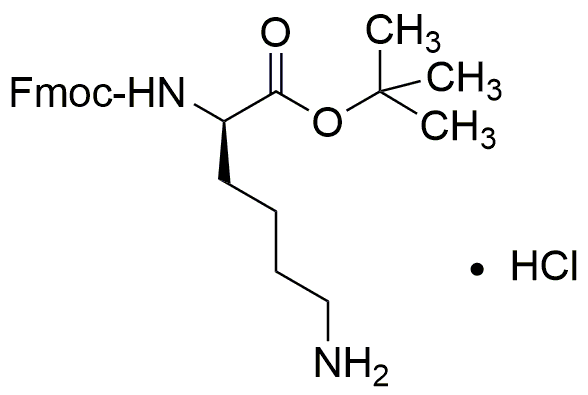Na -Fmoc-D-Lysine tert-butyl ester hydrochloride is widely utilized in research focused on:
- Peptide Synthesis: This compound serves as a key building block in the synthesis of peptides, particularly in solid-phase peptide synthesis (SPPS), allowing for the creation of complex peptide sequences with high purity.
- Drug Development: It plays a crucial role in the development of peptide-based drugs, offering a means to modify peptide structures for enhanced stability and bioactivity, which is essential in pharmaceutical research.
- Bioconjugation: The compound is used in bioconjugation processes, where it helps attach peptides to other biomolecules, facilitating the design of targeted drug delivery systems in cancer therapy.
- Protein Engineering: Researchers utilize this chemical to modify lysine residues in proteins, which can improve protein functionality and stability, making it valuable in biotechnology applications.
- Diagnostics: It is also applied in the development of diagnostic tools, where modified peptides can be used as biomarkers for disease detection, enhancing the sensitivity and specificity of tests.
General Information
Properties
Safety and Regulations
Applications
Na -Fmoc-D-Lysine tert-butyl ester hydrochloride is widely utilized in research focused on:
- Peptide Synthesis: This compound serves as a key building block in the synthesis of peptides, particularly in solid-phase peptide synthesis (SPPS), allowing for the creation of complex peptide sequences with high purity.
- Drug Development: It plays a crucial role in the development of peptide-based drugs, offering a means to modify peptide structures for enhanced stability and bioactivity, which is essential in pharmaceutical research.
- Bioconjugation: The compound is used in bioconjugation processes, where it helps attach peptides to other biomolecules, facilitating the design of targeted drug delivery systems in cancer therapy.
- Protein Engineering: Researchers utilize this chemical to modify lysine residues in proteins, which can improve protein functionality and stability, making it valuable in biotechnology applications.
- Diagnostics: It is also applied in the development of diagnostic tools, where modified peptides can be used as biomarkers for disease detection, enhancing the sensitivity and specificity of tests.
Documents
Safety Data Sheets (SDS)
The SDS provides comprehensive safety information on handling, storage, and disposal of the product.
Product Specification (PS)
The PS provides a comprehensive breakdown of the product’s properties, including chemical composition, physical state, purity, and storage requirements. It also details acceptable quality ranges and the product's intended applications.
Certificates of Analysis (COA)
Search for Certificates of Analysis (COA) by entering the products Lot Number. Lot and Batch Numbers can be found on a product’s label following the words ‘Lot’ or ‘Batch’.
Numéro de catalogue
Numéro de lot/série
Certificates Of Origin (COO)
This COO confirms the country where the product was manufactured, and also details the materials and components used in it and whether it is derived from natural, synthetic, or other specific sources. This certificate may be required for customs, trade, and regulatory compliance.
Numéro de catalogue
Numéro de lot/série
Safety Data Sheets (SDS)
The SDS provides comprehensive safety information on handling, storage, and disposal of the product.
DownloadProduct Specification (PS)
The PS provides a comprehensive breakdown of the product’s properties, including chemical composition, physical state, purity, and storage requirements. It also details acceptable quality ranges and the product's intended applications.
DownloadCertificates of Analysis (COA)
Search for Certificates of Analysis (COA) by entering the products Lot Number. Lot and Batch Numbers can be found on a product’s label following the words ‘Lot’ or ‘Batch’.
Numéro de catalogue
Numéro de lot/série
Certificates Of Origin (COO)
This COO confirms the country where the product was manufactured, and also details the materials and components used in it and whether it is derived from natural, synthetic, or other specific sources. This certificate may be required for customs, trade, and regulatory compliance.


